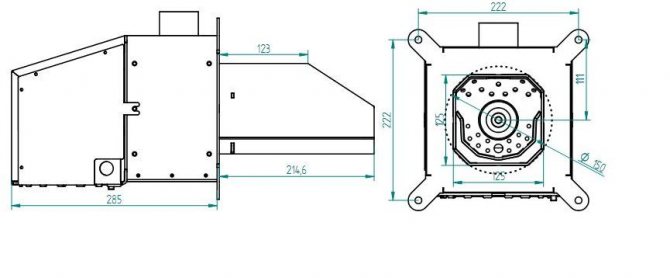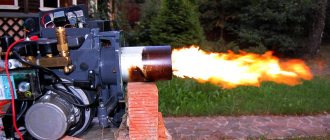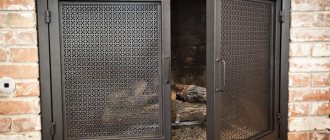The heating issue in the house has always been quite acute. The search for the best options continues to this day. Some choose solid fuel heating, while others stop on gas. One good option is a pellet burner.

In this article we will look at what this design is, what is the principle of its operation, features, advantages and disadvantages. Although the furnace mechanism is rather complex, we will consider the technology for its manufacture, since the furnace is expensive.
Why use a pellet burner
Pellets are the material for the firebox. We are not talking about ordinary pallets for transportation. Burner pellets are pressed wood in the form of small cylinders. Their diameter reaches 25 mm. They have successfully broken into the market and never cease to conquer it. People who have used such fuel note its high quality and use only it.
However, if the pellets are the same wood that is loaded into the firebox, why spend money and effort on creating an additional mechanism? Although this is logical, but in this case, the solid fuel material will burn by 80 or even 40%. The leftovers are simply disposed of. As a result, the efficiency of such a furnace is significantly reduced. If a burner is used, the combustion of the material will be 98%. The difference is significant.


Note! Pellets are not suitable for pyrolysis boilers. During operation, they harm him, and the equipment has to be serviced more often.
It is also important that the temperature inside the burner reaches 1000 degrees Celsius as the pellets are burned! That is why it is worth considering whether it is possible to put a pellet burner for your boiler. This is quite rational if you understand the principle of operation of a pellet burner during assembly, as well as follow the instructions. Then the burner will be an excellent addition to the boiler, improving its efficiency. The video shows a pellet burner and how it works.
The main task of the burner is to organize a powerful torch that will heat the boiler. A pellet burner is used for the same and consists of a small combustion chamber in the form of a wind tunnel. Pellets are fed into it from the bunker. A directed flame is generated by the air flow. The combustion chamber is made rectangular or round. The outer part consists of a screw conveyor. Fuel from the bunker is supplied through the inlet pipe. The next irreplaceable element is the fan. It will supply air to the bottom of the chamber.


The principle of operation is as follows: the pellets enter the chamber, where they are ignited. The fan turns on, supplying a minimum amount of air. When the flame ignites, the fan spins faster, blowing in more air. The result is an even and powerful torch. Factory burners are fully automated. The pellet burner controller allows you to regulate the supply of pellets, air, etc.
Features of the work
The device of a pellet burner assumes the presence of an even powerful torch, which is necessary to heat the water jacket. The intensity of the flame can be adjusted. To ensure the supply of husks and granules, a screw conveyor should be used, while fuel will flow into it from the loading hopper. The volume of the latter should be determined by how long the operation of the device will be.It is important to equip the structure with a fan that will blow air into the combustion area. Pellet burner drawings can be made by you yourself. It is important to take into account the estimated dimensions. For example, a combustion chamber can have both circular and rectangular cross-sections. The first option is somewhat more common, since manufacturing in this case is simpler. A flat fuel pan is installed in the round chamber, while the chamber itself is fixed to the flange plate. The latter must adhere to the outside of the device.
The pellet burner is one of the most economical devices combining:
- security;
- cheap fuel, moderate consumption and high level of efficiency;
- one of the advantages of this type of burner is the ability to automate the boiler room operation.
A solid-fuel type device in various modifications is produced mainly by foreign manufacturers. Their cost is not always available. However, if you have certain technical skills, making burners is permissible with your own hands at home.
Why pellets
For those regions where gas is not available, such biofuels are salvation. It is extremely efficient and cost effective. For comparison: burned 1 kg of pellets emit heat energy equal to 0.5 liters of diesel fuel. They are capable of delivering 5 kWh. To heat a one-story house in an area with mild winters, you need 50 kg of pellets per day. The advantage of fuel is that it can be filled up once for several days. It all depends on the boiler model. Pellets are loaded into the hopper, and then they are fed into the burner itself. A DIY pellet burner needs to be serviced twice every 7 days.


If we talk about the disadvantages of this solid fuel and burners, then this is the likelihood of reverse thrust. In this case, the fire will burst into the bunker. The result is a fire in the house. The second point concerns the amount and intensity of air supply. Pellets are lightweight, which means that the air flow sometimes blows them off the device. Then they will not burn. And when the air supply is small, the fuel is not completely burned. In order for the burner and stove to function correctly, it is important to adhere to the sequence.
You need to ignite the fuel with a ceramic rod lighter. It not only gives direct fire to raw materials, but heats up over 1,000 degrees. This is done so that during firing up the flame does not go into the hopper with other pallets. Further, air is fed in so that the combustion torch remains stable and even. After this, an exit to the operating mode occurs, since a large amount of air is supplied inside. The process can be stopped by stopping the air supply to the burner.
Malfunctions and their elimination
A do-it-yourself or purchased industrial pellet burner may have malfunctions caused by:
- the content of foreign inclusions in the pellets. It is diagnosed by the presence of dirty greenish slag in a stopped burner. Eliminated by cleaning the bunker or increasing the power and air consumption;
- using pellets of different diameters or sizes exceeding the required design. Leads to failure of the mechanical fuel supply elements, which can be restored only by complete replacement of parts;
- transition to a new pellet size. Possible stopping of the boiler in this case can be prevented by increasing the feed rate of wood pellets;
- using peat pellets, which causes contamination of the optical sensor and leads to an error indication. The solution to the problem is to replace it with wood fuel, or constant visual control;
Equipping boiler rooms with economical and automated solid fuel burners greatly simplifies the life of the inhabitants of the house.However, any technical device requires timely diagnostics and preventive maintenance. Clean up waste waste and take time to periodically inspect the technical condition of all elements of the boiler room. Such simple steps will allow you to get maximum safety and comfort.
What are pellet burners
Products are divided into several varieties. After reviewing them, we can choose the option that best suits different conditions. For example, in order for a pellet burner to function, electricity is needed to drive the mechanism. But what if the electricity in the area is often lost? This we will find out by considering the following types of burners:
- pellet burner with forced intake;
- gravity pellet burner.
Pellet burner with forced intake
This device is one of the best when it comes to fire safety in the house. The representative is the Teplodar pellet burner. The downside is the high cost of burners, reaching $ 3000. The burner has several mechanisms for supplying pellets inside. One mechanism operates the auger and the other operates the pneumatic system. The safety of the product lies in the fact that the channel runs from bottom to top (pellets move along it). The flame will move in the opposite direction, so it will not get into the bunker.
Note! Fuel is supplied in portions and does not remain in the channel through which it moves.
Another advantage is that pneumatic designs are equipped with large bins. They can be downloaded once a month.


As for the auger feeders, they have two main units. The first is the auger. He takes the pellets from the hopper, pouring them into another mechanism. Another auger lifts them directly into the burner. Even so, a fire is possible, as fuel remains along the entire length of the auger. For protection, engineers create another assembly that matches the material to the burner. It melts and self-extinguishes. This is a kind of fire cutoff.
The disadvantage of these mechanisms is that they are dependent on electricity. Without it, the supply of pellets stops, and even worse, the heating system may suffer. You need to supply power to two electric motors. In the case when the electricity is stable and does not disappear, then you can buy air blowing. With it, the combustion of pellets will be better, as well as the efficiency.
Gravity pellet burners
Such constructions are easier to use. Their great advantage is their performance even without power supply. The principle of operation of the device is to pour pallets into the firebox under its own weight. Pellet burner behemoth and pellet burner pelletron are the brightest representatives of gravitational products. They can be brought into operation by adjusting the flow damper and the draft regulator on the chimney. Minus designs - pellets in the hopper can ignite.


To solve the issue of fire hazard, manufacturers install thermal dampers on burners of this type. When the flame is pulled out of the hearth and moves to the bunker, a special sluice comes into play. It is heat activated. The airlock serves as a fire barrier. Another protection option is a double grate. It is a simple two-part mechanism. The upper one goes to the pellets and takes a certain amount of them. Further part is shifted to the flame. The second part begins to dump ash into the receiver.
Advice! For a double grate, it is also recommended to install a fire lock. The mechanism can jam, and the fire will penetrate to the pellets loaded into the bunker.
Do-it-yourself burner
How to make a pellet burner? The combustion chamber is made from a steel pipe. Wall thickness - 4 mm, not less. The steel is heat-resistant and will withstand high temperatures.Attachment to the boiler plant body is carried out by means of a flange plate. For manufacturing, steel 3 mm is required. It is better to buy a conveyor for feeding pellets or use an auger.
To rotate the mechanism, you need bearings, a low-speed motor (electric) and a gearbox. The air blower can be purchased at the store. It is fixed on the plastic, in which the place has already been prepared. The plate is made based on the drawing. The configuration depends on the boiler door itself. A drawing of the burner can be seen in this photo.


An obligatory step is to adjust the amount of incoming pellets and air. Without this, the device will be unstable or constantly at full power. To change the intensity of the fan and auger, you can set a manual regulator. In this case, you will have to constantly watch and adjust the burner, taking into account the temperature of the coolant and air.
It is important that for various work processes, fuel and air are correctly selected. Only then will the torch be even and stable. This requires an automated device. You will need a control unit. The controller for the burner has free control contacts, to which the electric motor from the auger and the fan is connected.


To automate the ignition of pellets and control the flame, you cannot do without a photosensor and an electric filament element. The photosensor monitors the appearance of a stable flame and notifies the controller. It will shut off the filament element. But the incandescent element is needed to ignite the pellets. The delivery pipe is equipped with a filling sensor. It stops feeding the pellets when the auger and the top nozzle are full.
Preparatory work
A do-it-yourself pellet burner cannot be made without the main component of the same name, which is recommended to be purchased in the store. This is due to the fact that the burner itself has a rather complex design, and although it is possible to make it yourself, such manipulations are difficult to implement. The burner is an element where the fuel is ignited, however, it also regulates the intensity of the flame. Among other things, the design will include sensors and programmers that allow for more economical fuel consumption. With the help of these elements, it will be possible to achieve a comfortable indoor temperature. The pellet burner must have a housing that is recommended to be placed horizontally. This will allow the most efficient use of the heat recovered from the combustion of the fuel. Sheet steel can act as a material for forming the body, but experts sometimes advise using cast iron or brick. You can choose the material that, in your opinion, is able to keep warm longer. The housing must ensure high-quality heat transfer to the next element of the device, that is, the heat exchanger.
The pellet burner must have a heat exchanger that is located inside the body. It looks like several pipes, which are sometimes replaced by a coil. They are connected to the building's heating system. Among other things, an inlet for pouring cold water should be provided. When making a combustion chamber, a hole should be provided in it, the diameter of which should be equivalent to the parameters of the purchased burner. The 100mm auger and electric motor will work in tandem. The latter is to be connected to the device control unit.























